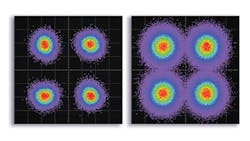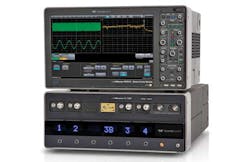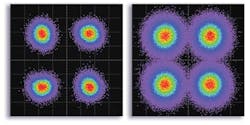This file type includes high resolution graphics and schematics when applicable.
Digital oscilloscopes have long been measurement workhorses for high-frequency electronics, especially as they have moved higher in frequency. The new LabMaster 10-100Zi real-time oscilloscope from Teledyne LeCroy is both versatile and powerful, with a real-time analog bandwidth of 100 GHz that is being strobed at sample rates to 240 GSamples/s. The oscilloscope can be run in a number of different multiple-channel modes—as well as in conjunction with computer-aided-test (CAT) and computer-aided-engineering (CAE) software programs—for flexible measurements of the most complex analog and digital signals.
The LabMaster 10-100Zi real-time oscilloscope (Fig. 1) builds upon the modular architecture of the company’s lower-frequency LabMaster 10 Zi oscilloscopes, using a two-housing format to deliver a great deal of flexibility. A basic LabMaster 10-100Zi includes a LabMaster MCM-Zi Master Control Module and a LabMaster 10-100Zi Acquisition Module. Modules of each kind can be added as required to form an almost unlimited number of different measurement configurations. Examples include a real-time oscilloscope with multiple 100-GHz channels and a test system with various combinations of 36-, 65-, and 100-GHz measurement channels.
The modular system can be equipped with as many as 20 acquisition modules under the command of a single MCM-Zi control module. It can then form an oscilloscope with as many as 80 measurement channels, each operating at a real-time bandwidth of 36 GHz and sampling rate of 80 GSamples/s; as many as 20 measurement channels, each at a real-time bandwidth of 100 GHz and sampling rate of 240 GSamples/s; and anything in between. At the maximum bandwidth, the oscilloscope exhibits less than 130 fs RMS jitter between channels. Communication between each of the acquisition modules and the CPU is performed by means of high-speed PCIe connections.
Each control module includes a display, operating controls, central processing unit (CPU), and distributed system clock—a highly stable 10-GHz source that maintains precise synchronization among all of the oscilloscope channels. Digital PCIe data connections from the control module to the LabMaster MCM-Zi Acquisition Modules provide transfer of data and control signals. Although each oscilloscope system is capable of acquiring enormous amounts of data, the design employs the firm’s proprietary X-Stream II streaming technology to process and manage large amounts of data without compromising data precision and integrity.
The 240-GSamples/s digitizing speed of the LabMaster 10-100Zi real-time oscilloscope means that test samples are acquired at time intervals as brief as 4.17 ps, allowing capture of extremely short events like laser and radar pulses. As communications systems grow in complexity, the timing and synchronization between channels become more finely tuned, requiring more sophisticated measurement capabilities as provided by the LabMaster 10-100Zi. Patented innovations such as digital bandwidth interleaving (DBI) and ChannelSync multiple-module synchronization ensure that separate modules function as a single unit.
Through their use, measurement modules can be added with confidence as channels are needed for various tasks—such as analyzing the complex signals found in digitally modulated signals with in-phase (I) and quadrature (Q) signal components—to a top limit of 80 synchronized measurement channels (each with a real-time bandwidth of 36 GHz). As noted earlier, the usable real-time measurement bandwidth is a function of the number of channels, with as many as 20 real-time measurement channels available at the 100-GHz bandwidth.
The ChannelSync architecture features impressive synchronization, with less than 130 fs channel-to-channel jitter. The oscilloscope draws this tight timing from a microwave reference source, a 10-GHz ChannelSync distributed clock that accounts for the precise synchronization among the as many as 80 measurement channels. The clock accuracy is better than 0.1 ppm + aging rate of 0.1 ppm/yr from the last calibration. The sample clock jitter, for acquired time durations to 3.2 ms, is only 50 fs RMS. For twice the acquired time, to 6.4 ms, the sample clock jitter increases to 130 fs RMS.
The LabMaster 10-100Zi offers wide ranges of time/division scales, depending on measured bandwidth. For measurement bandwidths greater than 36 GHz, time/division scales from 10 ps/div to 640 μs/div. For measurement bandwidths less than or equal to 36 GHz, the time/division scale extends from 10 ps/div to as long as 256 s/div (for truly long events or widely spaced events). Jitter between channels, measured at the maximum bandwidth, is less than 130 fs RMS. The trigger and interpolator jitter is typically less than 0.1 ps RMS when software assisted, and typically 2 ps as a result of the hardware alone.
The LabMaster 10-100Zi features flexible triggering capabilities, with the firm’s SMART Triggers that enable triggering on any input source if it can be state or edge qualified. The instrument system can trigger on signal event widths, with widths selectable from 200 ps to 20 s, or on intermittent faults, triggering on intervals between 1 ns and 20 s. The oscilloscope system supports maximum trigger rate of 1 million waveforms/s for as many as four channels.
A high-speed oscilloscope system such as the LabMaster 10-100Zi can capture and display the growingly complex signals of optical and digital communications systems, such as these 80 and 160 GBaud quadrature-phase-shift-keying (QPSK) signals (Fig. 2). These measurements were made at Alcatel-Lucent’s famed Bell Labs, using with a two-channel LabMaster 10-100Zi system with 100-GHz real-time bandwidth.
Because custom analysis often must be performed on captured high-speed test signals, the LabMaster 10-100Zi teams with a number of different software tools. The high-speed oscilloscope is equipped with the XDEV software package that allows users to run custom MATLAB code from The MathWorks for general-purpose signal analysis.
When more specific analysis is needed (for example, examining high-speed optical signals), software developed for optical modulation analysis can just as easily be used with the LabMaster 10-100Zi instruments. For instance, the SDAIII-CompleteLinQ software can be used with the LabMaster 10-100Zi for eye, jitter, and noise analysis on as many as four signal lanes simultaneously.
Physically, the LabMaster 10-100Zi master control module measures 10.9 × 18.2 × 15.6 in. (277 × 462 × 396 mm) and weighs 47 lbs (21.4 kg). The master acquisition module measures 8.0 × 18.2 × 26.0 in. (202 × 462 × 660 mm) and weighs 58 lbs (24 kg). The control module also includes a port for an external 10-MHz timebase reference and provides access to a 10-MHz reference signal (at 50 Ω) for use with other test instruments. P&A: $900,000 and up; stock.
Teledyne LeCroy, Inc., 700 Chestnut Ridge Rd., Chestnut Ridge, NY 10977; (800) 5-LeCroy
This file type includes high resolution graphics and schematics when applicable.
About the Author
Jack Browne
Technical Contributor
Jack Browne, Technical Contributor, has worked in technical publishing for over 30 years. He managed the content and production of three technical journals while at the American Institute of Physics, including Medical Physics and the Journal of Vacuum Science & Technology. He has been a Publisher and Editor for Penton Media, started the firm’s Wireless Symposium & Exhibition trade show in 1993, and currently serves as Technical Contributor for that company's Microwaves & RF magazine. Browne, who holds a BS in Mathematics from City College of New York and BA degrees in English and Philosophy from Fordham University, is a member of the IEEE.



